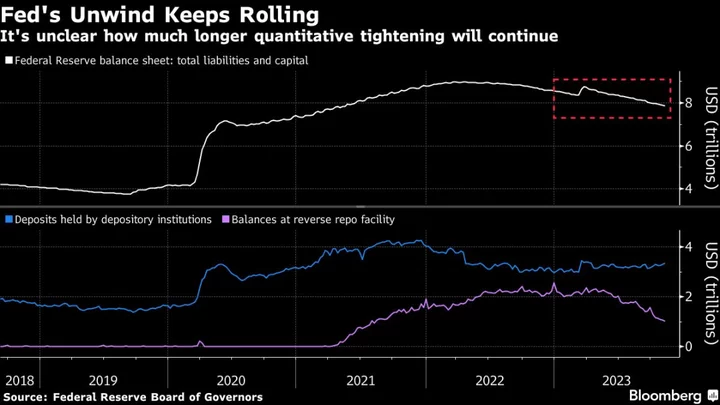The Federal Reserve should stop cutting its bond holdings before a key liquidity facility is completely emptied so it can ensure that banks have sufficient reserves, according to Wrightson ICAP.
There’s uncertainty surrounding the level of reserves that the banking system needs before they become scarce and institutions rely more heavily on short-term funding markets.
Fed officials see those reserves — currently at $3.36 trillion — as sufficient and have been allowing the central bank’s bond holdings to drop by not buying new securities to replace those that mature. That’s pulling excess cash from the system as others buy the newly issued Treasuries instead.
The process, known as quantitative tightening, helped to drain over $1 trillion since June from the Fed’s reverse repurchase facility, where money-market funds go to earn interest on extra cash, leaving about $1 trillion parked there. While bank reserves are at a still seemingly abundant level, the Fed hasn’t spelled out a hard and fast target level.
But Wrightson ICAP economist Lou Crandall said in a note Monday that the Fed should stop paring its bond holdings before the facility is completely emptied to make sure that banks’ cash buffers don’t get too lean and increase pressure on short-term funding markets.
“We think banks should be encouraged to hold deep liquidity buffers, so our preference would be to adopt a generous definition of ‘ample,’” Crandall wrote. “Surplus cash sitting in the RRP facility can be redeployed by money funds into the repo market in the event of a spike in financing needs.”
Reserve scarcity has caused overnight lending rates to jump in the past, notably in 2019, when the Treasury increased its borrowing and the Fed stopped buying as many Treasuries for its balance sheet.
At that time, policy makers were trying to determine the lowest comfortable level of reserves the banking system needed. That’s similar to the current environment, with banks contending with losses on securities portfolios and an uncertain economic outlook.
Yet even as usage of the Fed’s reverse repo facility has declined, that hasn’t caused any hiccups in the short-term markets where financial institutions borrow cash. The effective fed funds rate has remained unchanged at 5.33% and has held squarely in the central bank’s target range of 5.25% to 5.5%.
Bank of America Corp. strategists Mark Cabana and Katie Craig have noted that bank reserves remain higher than when the Fed began its qualitative tightening, indicating they may have little interest to reduce the cushions further.
It’s unclear exactly how much Fed officials think reserves should shrink, though. In a speech on Friday, Dallas Fed President Lorie Logan presented a normalization framework that implied a lower level than Wall Street strategists have recommended. Other policy makers have stressed that they’re watching market conditions to see how they manage bank balances.
The Fed “may choose to manage the transition from abundant to ample cautiously even if their long-run objective is a leaner balance sheet,” Crandall wrote. “However, it may take some time for that debate to come into clearer focus.”









